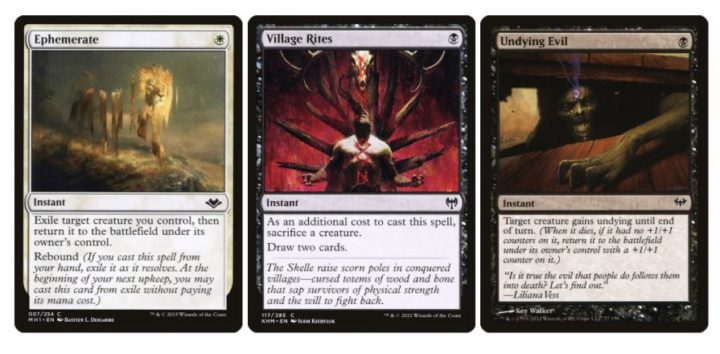I’m no counselor, but we should probably talk about Grief.
Weekly MTG previewed a bunch of cards ahead of the official start of Modern Horizons 2’s preview season, and Grief was easily the standout. The card has already has brewers in a tizzy to find the best shell for it and the optimum cards that work with it.
Grief is effectively the proactive equivalent to Force of Will. While Force’s paid analog is Negate, Thoughtseize is analogous to Grief. When cards of this level of raw power are being used to estimate potential, you know you’re probably talking about the real deal. It’s important to note that Grief is a much better topdeck than Thoughtseize in the later game, and having your disruption double as a threat in a pinch is a killer advantage.
Synergistic Cards & The Thoughtseize Test
I’ve seen three main suggestions for cards that might work well with Grief: Ephemerate, Village Rites, and Undying Evil. They all look to gain additional value from the Elemental Incarnation in some way, but are any of these combos better than just casting Thoughtseize? I’m going to run the numbers with each of these cards, and put them through a standardized scenario to see how they perform.

The scenario is very simple: Each player starts with seven cards in hand, and you’re on the play. You’re looking to play Grief on turn one and immediately use one of these cards in conjunction with it. Meanwhile, on each of their turns, your opponent will play a land and then play one card from their hand. I’ll be looking at the number of cards in your hand and your opponent’s hand, the amount of value gained, and the overall impact on the game.
It’s worth noting that this approach to card analysis and evaluation isn’t perfect, nor will it give you the full picture. Every scenario is subject to context, and outcomes may vary wildly based on the match-up, or whether you’re on the play or draw.
With that disclaimer out of the way, let’s start off with the control scenario: Casting a turn one Thoughtseize!
Thoughtseize Scenario
Turn 1 – You
- Play a land
- Play Thoughtseize
- Remove a card from opponent’s hand
Turn 1 – Opponent
- Draw a card
- Play a land
- Play a one-drop
Turn 2 – You
- Draw a card
- Play a land
- Play a two-drop
Cards in hand: 4
Cards in opponent’s hand: 5
This is a classic Modern opening, and one that’s the bane of many a combo player. It’s efficient, requires no setup, and can turn a decent hand into a terrible one. There isn’t much to be said about a turn one Thoughtseize that Reid Duke hasn’t said already. No matter how good Grief’s performance is, this will remain a pillar of the Modern format.
So, now we have our control case, how will each of our experiments play out? Let’s take a look.
Scenario 1 – Grief/Ephemerate
Turn 1 – You
- Play a land
- Play Grief, exiling a black card
- Remove a card from opponent’s hand
- Ephemerate Grief
- Remove a card from opponent’s hand
Turn 1 – Opponent
Turn 2 – You
- Ephemerate rebounds, targeting Grief
- Remove a card from opponent’s hand
Cards in hand: 2
Cards in opponent’s hand: 3
Result: you get to pick apart your opponent’s hand at the expense of your own card advantage. Your opponent ends up with more cards in hand than you, but you have likely destroyed their game plan, and you have a reasonable threat on board that they may not be able to answer for several turns. Not only that, but the way evoke works allows you exceptional agency in this scenario. You can stack the triggers so that you take a card before Grief’s evoke trigger kicks in, and if you don’t feel the need to disrupt further, you can just let it die. You’ll have saved that Ephemerate for a later moment that might be more impactful, rather than removing cards you’re not concerned about.
Interestingly, if you’re on the draw, using Ephemerate on turn 1 is still a powerful and extremely brutal option, even in the face of removal. You stack the evoke and enter the battlefield triggers in the same way as I just mentioned, and if your opponent has removal, they’ll feel forced to use it on Grief before you can take it from them. If you have the Ephemerate, you can flicker it to fizzle the removal and still take three cards from your opponent (including the effect of Ephemerate’s rebound). This just punishes opponents even further for trying to interact.
Scenario 2 – Grief/Village Rites
Turn 1 – You
- Play Grief, exiling a black card
- Cast Village Rites, sacrificing Grief
- Draw 2 cards
- Remove a card from opponent’s hand
Turn 1 – Opponent
Turn 2 – You
Cards in hand: 4
Cards in opponent’s hand: 5
Result: You end up with approximately the same result as Scenario 1, except you each have slightly more cards in hand. You have less of a battlefield presence, but you have the opportunity to poke a hole in the opponent’s game plan, hopefully long enough to pull ahead. You also have excellent card velocity compared to the other scenario, as you’ll have seen 10 total cards in your deck by turn two.
Scenario 3 – Grief/Undying Evil
Turn 1 – You
- Play Grief, exiling a black card
- Remove a card from opponent’s hand
- Play Undying Evil, targeting Grief
- Remove a card from opponent’s hand
Turn 1 – Opponent
Turn 2 – You
Cards in hand: 2
Cards in opponent’s hand: 4
Result: This is very similar to Scenario 1, but with two big flaws: your opponent ends up with one more card by comparison, and you have to run Undying Evil. It’s a neat card, but it’s just not good by itself.
Ephemerate can blink something for value, often creating virtual or actual card advantage. Village Rites can blank removal by trading itself and a creature for two new cards. Village Rites may not generate card advantage by itself, but if you’re sacrificing a creature to it, chances are it provided some value already; this means it can be anywhere from virtual to actual card advantage, depending on the context.
Undying Evil unfortunately doesn’t pan out the same way. First, you either need a creature that’s being targeted by removal, or you need a sacrifice outlet; second, if the removal is Path to Exile, it doesn’t work; third, it’s a terrible topdeck. At least you can cash in Ephemerate or Village Rites on your terms, provided that you have a creature in play.
After seeing the outcomes from these basic scenarios, it’s clear to see that Grief’s effects can be devastating, especially when you try to take advantage of it. There are two main questions that still need to be answered about Grief, however:
Is Grief worth the slots if you’re not trying to abuse it?
The answer here isn’t so clear-cut. If you’re running a black-heavy deck that already has some hand disruption, then it’s an easy enough inclusion. It may be better as a sideboard card against tough combo match-ups, however, particularly if your deck doesn’t have many ways to capitalize on the immense speed bump it puts in your opponents’ way.
If you’re a heavy value-oriented deck, it’s much easier to justify. There have been recent B/W Stoneblade/Pox hybrid lists that could be well-suited to take advantage of the card. They have a high number of black cards to evoke Grief easily, but they’re also grindy enough that they won’t have an issue just casting it for full retail later in the game. Here’s a list that you can use as a starting point.
There could also be some number of unfair decks that might choose to include it in their arsenal, as a way to protect their combo. Living End is a perfect example. It has seen a small resurgence lately, and has moved from its original black base to a blue shell in order to take advantage of Force of Negation. It might be a better choice for Living End to return to the black creatures instead, so it can make use of Grief. Besides, Faerie Macabre gives you main deck graveyard hate, Fulminator Mage can be extremely effective in the right metagame, and Archfiend of Ifnir prevents opponents from mounting a defense against you. There are also a number of benefits to Grief that may outweigh Force of Negation: it can’t be stopped by an opposing Force, it will come back with Living End and remove any potential out your opponent might have, and it lets you check to see if the coast is clear. It does mean you will have to cascade on your own turn more often, so there are some downsides, too. This sample list that would serve as a good starting point.
What restraints does it place on the deck building process?
Grief will be subject to very similar deck building requirements and concessions as the likes of Force of Negation, though there will be exceptions. You’ll usually need to make sure that you can reliably cast it for free on turn one, which means you should aim to have at least 15-20 black cards in your deck. This won’t always be the case, however.
Where Grief differs from Force of Negation is that there will be decks that will look to include it as a reasonable creature by itself, and not look to always evoke it for free. Orzhov Blink decks might want to include a few copies, despite having a typically low number of black cards, for example. Most of the time, it’ll just be a decent use of your Aether Vial as you tick it up to five for Yorion, Sky Nomad, but there will be the occasional spot where the free Thoughtseize will come in clutch.
Conclusion
I think Grief is a great card by design. It’s powerful and efficient, but its uniqueness is what sets it apart from the others. In terms of playability, it is absolutely going to show up in multiple decks, particularly right after set release. I would still prefer to play Thoughtseize in most decks, however, unless there is a specific reason to trade card advantage for ruthless efficiency.
Its synergy with Ephemerate is still a particular concern for me, mostly because both cards are excellent by themselves, but together they are back-breaking. Ephemerate will continue to get better with every set release, and Grief might be the card that really thrusts it into the spotlight in Modern. The sheer thought of this possibility is already giving me, well… Grief.
What do you think of Grief? Do you think it will break Modern? Do you have any other cards that could work well with it? Let me know your thoughts over on Twitter!

Scott is an Irish content creator and the Head of Budget Magic for the Izzet League. He focuses on affordable decks in Pioneer, Modern, and Pauper, particularly ones that stray from the mainstream. When he’s not writing about his favorite decks, he can be found talking incessantly about them on Twitter and on The Budget Magic Cast.

